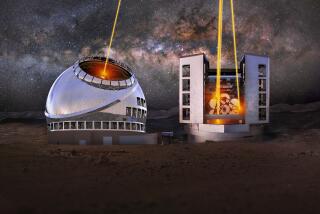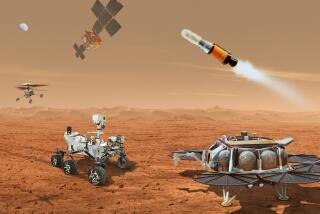Hubble tune-up is a go
- Share via
NASA Administrator Michael D. Griffin gave the go-ahead for a repair mission to the Hubble Space Telescope on Tuesday, declaring the goal of saving one of the space agency’s most popular science missions to be worth the risk of a shuttle flight.
The mission would launch as early as May 2008, carrying new cameras, batteries and gyroscopes. Hubble is operating on only two of six gyroscopes and battery power is running down. Without the repair mission, the telescope would become space junk by 2009, at the latest.
The new equipment would keep the space telescope, which has transmitted thousands of images and helped to answer some of the deepest questions about the universe since its launch 16 years ago, operating until at least 2013.
Though NASA has conducted four servicing missions to Hubble, there are still risks. A major problem is that if the shuttle encounters trouble, there will be no way to reach “safe haven” at the International Space Station, which orbits at a different altitude and direction.
“We all know flying the shuttle carries more risk than we would like,” Griffin told a packed auditorium at Goddard Space Flight Center in Greenbelt, Md., where the Hubble program is based. “It can be flown safely, if we are careful.”
The new instruments will enable the telescope, orbiting 333 miles over Earth’s surface, to probe the secrets of the first few hundred million years after the Big Bang, the theorized event that created all the matter and energy in the universe. Scientists are hopeful that it will help unravel such cosmological mysteries as the source and location of dark energy and matter.
“It’s a great day for science,” said Sen. Barbara A. Mikulski (D-Md.), one of the strongest backers in Congress of a Hubble relief mission. “The Hubble telescope has been the greatest telescope since Galileo.”
With the repairs and upgrades, “we are essentially going to get a new Hubble,” Mikulski said.
The repair mission is expected to cost about $900 million, but Mikulski announced she would introduce legislation with Sen. Kay Bailey Hutchison (R-Texas) to reimburse the space agency as much as $1 billion in expenses.
In deciding to go ahead with the repair mission, Griffin reversed a decision by his predecessor, Sean O’Keefe, who said the danger to astronauts was simply too great. O’Keefe made his decision in the aftermath of the Columbia disaster in 2003. Columbia was damaged by insulating foam flaking off the shuttle’s giant external fuel tank and was destroyed on reentry.
O’Keefe said future shuttle flights would only go to the space station.
Because the shuttle crew repairing Hubble would be unable to reach the station, they would have to wait in space for a rescue ship, relying on provisions they bring with them.
Griffin said upgrades to the shuttle since the Columbia accident have made it a safer vehicle. The shuttles Discovery and Atlantis have flown three missions safely in the last two years. Astronauts have also tested several repair techniques that could be used to patch holes in the spacecraft caused by falling insulating foam. Griffin said the repairs survived tests back on Earth.
Past astronaut crews have expressed reservations, however, at trusting their lives to repairs in space. One danger is that any repair made in space might interfere with the aerodynamics of the spacecraft as it enters Earth’s atmosphere, potentially making things worse.
John Pike, director of GlobalSecurity.org, a defense and space policy research firm, said the decision to launch a Hubble repair mission is ill-advised. “It has always struck me as daring the fates,” he said. “It seems to me they are taking a big chance.”
Most former astronauts and scientists contacted Tuesday supported the mission. “I think it’s a great idea,” said Rusty Schweikert, a former Apollo astronaut.
“After more than a decade of fascinating discoveries, the Hubble Space Telescope will soon be given the new beginning that it deserves,” the European Space Agency said in a statement.
The Hubble Space Telescope was launched in 1990. Over its lifetime, it has provided such images as gas pillars in the Eagle Nebula, a dust disc around a black hole in galaxy NGC 7052, and the luminous Sombrero Galaxy. It has been NASA’s most popular mission since the grand days of the lunar landings more than three decades ago.
But from the start, Hubble was plagued with problems. The excitement surrounding its launch yielded quickly to embarrassment when scientists discovered it had a faulty mirror. Coming on the heels of the Challenger shuttle disaster in 1986, the problem with Hubble was a low point for NASA.
A repair mission launched three years later installed, in Mikulski’s words, “the most expensive contact lens in history.”
Since then, there have been three other repair and upgrade missions, the most recent in March 2002, when astronauts installed the Advanced Camera for Surveys. It captured the most distant image of the universe ever taken.
The next mission will carry two new instruments for installation over the course of four or five spacewalks. The Wide Field Camera-3 and the Cosmic Origins Spectrograph will help analyze the composition of distant galaxies, stars and even planets orbiting other stars. Spacewalkers will also attempt to repair the Space Telescope Imaging Spectrograph.
Six new batteries and gyroscopes will also be attached, along with a soft capture docking mechanism that will make it easier to make future repairs, should they be necessary.
The work will be difficult. For one repair, astronauts must remove 111 bolts. Engineers have had to invent a new kind of face plate to keep the bolts from floating away.
Space scientists hope that by repairing Hubble, it will provide a smooth transition in space-based science to the next generation orbiting telescope, the James Webb Space Telescope. That instrument had been scheduled to launch in 2011, but higher costs have pushed it back to 2013.
In case something goes wrong, a second space shuttle will be sitting on pad 39B at Kennedy Space Center in Florida. It will be ready to blast off on a rescue mission within 25 days. The shuttle carrying the repair crew will have enough food and water to last that long.
Griffin said he believes there is only a tiny chance a rescue mission will be necessary, but pledged, “We will carry the rescue option on our manifest.”
*
john.J[email protected]
*
Begin text of infobox
Fix-it trip
The problem
The space telescope is getting old. Several instruments have failed or are degrading. It’s operating on only two of six gyroscopes and battery power is running low. Without the repairs, the telescope would fail by 2009 at the latest.
The repair
Astronauts will install six gyroscopes and batteries. They also will replace a camera and install a new spectrograph to measure distances and composition of galaxies and planets. With the upgrades, Hubble is expected to operate until at least 2013.
The cost
About $900 million.
The risks
As with any shuttle launch, there is about a 1% to 2% chance of losing the craft. Also, if the craft is damaged during liftoff, the crew won’t be able to retreat to the International Space Station. They would have to wait for rescue at Hubble.
*
Source: Los Angeles Times staff
More to Read
Sign up for Essential California
The most important California stories and recommendations in your inbox every morning.
You may occasionally receive promotional content from the Los Angeles Times.










